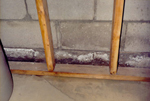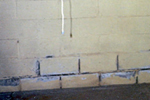For decades, thousands of satisfied homeowners have relied on The B-Dry System to solve their wet basement problems.
For more information, immediate assistance or a free estimate, select one of the options below.

Efflorescence Chalky - White Deposits
White or chalky stains are usually signs of efflorescence.
Efflorescence is caused by water or moisture being absorbed into the porous masonry materials and later forming crystalline deposits as the materials dry out. The walls or floor will show white stains when dry.
The calcium and lime ingredients in cement are dissolved by water and later re-crystallize as they dry out and form "efflorescence".
Causes of Efflorescence
There are several reasons efflorescence can form:

Excessive Humidity - A reason you'd want to suspect that your efflorescence problem is caused by humidity would be the existence of even or uniform white stains over a broad area. This is usually a sign that moisture is "forming" on the surfaces rather than leaking in. Leaks, on the other hand, usually occur in specific areas like cracks or joints that open with the expansion and contraction that comes from settling or temperature changes.
Solutions for High Humidity: Set up a decent dehumidifier to control moisture and humidity levels. By physically removing the extra moisture from the air, it will encourage the masonry walls and floor to dry out. It will also prevent future moisture and condensation problems from occurring. Make sure your windows and doors stay closed to limit outside air or the more humid air from upstairs from entering the basement.
Leaking Cracks or Mortar Joints - If the efflorescence is limited to the mortar joints, chances are that the original outside waterproofing or parging (a thin cement coating outside the foundation) has developed cracks in it or has broken down. Water outside the foundation walls forces its way in through hairline cracks and is absorbed into the porous mortar through capillary action. When the water or moisture dries out, crystals form from the lime calcium and other masonry ingredients that were dissolved by the water.
Solutions for Cracked Walls or Mortar: If the walls are not very deep below the surface, they can be dug out and re-parged again. This would require properly cleaning the outside walls of soil and broken down parging. A new coating should have elastic properties to resist cracking when the foundation expands and contracts from temperature differences and changing seasons.
This type problem can also be addressed from "inside" by drilling through the cracks and injecting urethane grout into the cracks or outside the wall. Urethane grout expands to seal out water. Inside, basement efflorescence repair can be done by brushing the white material off. It is generally not a structural issue.
This can also be remedied by installing waterproof rigid sealer panels to the interior walls combined with weep holes to drain the hollow block cavities and an interior drainage system to drain the water and relieve interior hydrostatic pressure. Carefully read any warranties to decide which application is best for your needs.
Basement efflorescence and stains can be removed with a stiff wire brush or wire wheel.
© 2017 B-Dry Owner's Association
RECOMMEND THIS PAGE